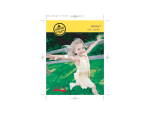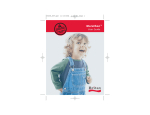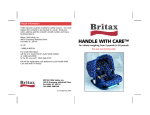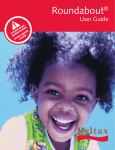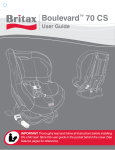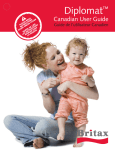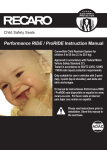Download Britax Car Sea Car Seat User Manual
Transcript
P2219_R02f.qxd 11/7/2002 10:23 AM Page 1 P2219_R02f.qxd 11/7/2002 10:23 AM Page 2 Table of Contents Introduction . . . . . . . . . . . . . . . . . . . . . . . . . . . . . . . . . . . . . . . . . . 2 Safety Information . . . . . . . . . . . . . . . . . . . . . . . . . . . . . . . . . . . . 3–5 Child Restraint Features . . . . . . . . . . . . . . . . . . . . . . . . . . . . . . . . 6–7 Vehicle Safety Belts . . . . . . . . . . . . . . . . . . . . . . . . . . . . . . . . . . . . . 8 Vehicle Seating Positions . . . . . . . . . . . . . . . . . . . . . . . . . . . . . . . . . 9 Installation . . . . . . . . . . . . . . . . . . . . . . . . . . . . . . . . . . . . . . . 10–15 Installation with LATCH. . . . . . . . . . . . . . . . . . . . . . . . . . . . . 10–11 Installation with Lap-Shoulder Belt . . . . . . . . . . . . . . . . . . . . . 12–13 Installation with Lap Belt Only. . . . . . . . . . . . . . . . . . . . . . . . 14–15 Versa-Tether™ . . . . . . . . . . . . . . . . . . . . . . . . . . . . . . . . . . . . . 16–17 Using Restraint Features . . . . . . . . . . . . . . . . . . . . . . . . . . . . . 18–19 Securing Your Child . . . . . . . . . . . . . . . . . . . . . . . . . . . . . . . . . 20–21 Harness Height Adjustment . . . . . . . . . . . . . . . . . . . . . . . . . . . 22–23 Adjusting Buckle Position . . . . . . . . . . . . . . . . . . . . . . . . . . . . . . . 23 Care and Maintenance . . . . . . . . . . . . . . . . . . . . . . . . . . . . . . . 24–27 Cover. . . . . . . . . . . . . . . . . . . . . . . . . . . . . . . . . . . . . . . . . . 24–25 Harness . . . . . . . . . . . . . . . . . . . . . . . . . . . . . . . . . . . . . . . . . . . 25 Shell . . . . . . . . . . . . . . . . . . . . . . . . . . . . . . . . . . . . . . . . . . . . . 25 Buckle . . . . . . . . . . . . . . . . . . . . . . . . . . . . . . . . . . . . . . . . . 26–27 Warranty . . . . . . . . . . . . . . . . . . . . . . . . . . . . . . . . . . . . . . . . . . . . 28 This product and its components are subject to change without notice. © 2 0 0 2 B r i t a x C h i l d S a f e t y, I n c . A l l r i g h t s r e s e r v e d . “Britax” is a registered trademark. Printed in U.S.A. P2219_R02f.qxd 11/7/2002 10:23 AM Page 4 Introduction • Read and understand this information booklet before using this product. To ensure proper restraint use, store this booklet so you can consult it often. • This child restraint is designed for use only by children who weigh between 22 and 80 pounds (10 and 36 kg) and whose height is between 19 and 53 inches (48.3 and 134.6 cm). • This child restraint system conforms to all applicable Federal motor vehicle safety standards. This Restraint is Not Certified for Use in Aircraft. • This child restraint must not be used in the home, in boats, or other non-certified applications. • This child restraint is LATCH compatible. Fill out the registration card and mail it in today! Child restraints could be recalled for safety reasons. You must register this restraint to be reached in a recall. Send your name, address, and the restraint's model number and manufacturing date to Britax Child Safety, Inc. 13501 South Ridge Drive Charlotte, NC 28273 or call 1-888-4BRITAX. For recall information, call the U.S. Government's Auto Safety Hotline at 1-800-424-9393 (202-366-0123 in DC area). 2 Safety Information • Verify that the child restraint is secure and that the harness is properly adjusted around your child each time you use the child restraint. • Adjust the harness to fit the clothes the child is wearing. The harness will fit a child in winter clothes differently than a child in summer clothes. • Cover the child restraint if your vehicle is parked in direct sunlight. Parts of the child restraint can become hot enough to burn a child. • Store the child restraint in a safe place when it is not being used. Avoid placing heavy objects on top of it. • To prevent injury due to deterioration or hidden damage, discontinue use of a child restraint that is older than six years or has been in a severe crash. • Do not leave children alone in a vehicle, even for a short time. • Do not, except as described in this booklet, attempt to disassemble any part of the child restraint or change the way its harness or your vehicle restraint belts are used. • Do not leave loose objects, e.g. books, bags, etc., in the back of your vehicle. In the event of a sudden stop, loose objects will keep moving, potentially causing serious injuries. • Do not leave folding vehicle seats unlatched. In the event of a sudden stop, a loose seat back could prevent the child restraint from protecting your child as well as it should. • Do not allow children to play with the child restraint. • Do not use anything to raise the restraint off the vehicle seat. In an accident, it could slide and be unable to protect your child as well as it should. 3 P2219_R02f.qxd 11/7/2002 10:23 AM Page 6 Safety Information • FAILURE TO FOLLOW EACH OF THE FOLLOWING INSTRUCTIONS CAN RESULT IN YOUR CHILD STRIKING THE VEHICLE’S INTERIOR DURING A SUDDEN STOP OR CRASH. SECURE THIS CHILD RESTRAINT WITH A VEHICLE BELT AS SPECIFIED IN THIS USER GUIDE. • USE THE VEHICLE’S LATCH SYSTEM, LAP-SHOULDER BELT SYSTEM, OR LAP BELT SYSTEM TO SECURE THE RESTRAINT. ALWAYS USE THE VERSA-TETHER FOR CHILDREN WEIGHING MORE THAN 50 POUNDS (22.6 kg). • Use vehicle belt (not LATCH connectors) for installations with children weighing more than 48 pounds (21 kg). Refer to the vehicle owner’s manual or contact the vehicle manufacturer for the maximum weight rating for their LATCH anchors. Unless specified otherwise by the vehicle manufacturer, assume a 48-pound child is the vehicle LATCH anchor limit. • Install this child restraint only on vehicle seats which face forward! Do not install this restraint on vehicle seats facing sideways or backwards! • Secure this child restraint with the vehicle belts or LATCH even when it is not occupied. In a crash, an unsecured child restraint may injure vehicle occupants. 4 Safety Information • Based on accident statistics, the National Highway Traffic Safety Administration recommends that parents select the rear seat as the safest location for a properly installed child restraint. Please study the section on Vehicle Safety Belts in this booklet to ensure the safety of your child. If in doubt about installing your child restraint, consult your vehicle owner’s manual. • Britax recommends that all child restraints be installed in the rear seat. • The primary protection for occupants of a vehicle in a collision is the body of the vehicle itself; a child restraint will not protect a child when the vehicle is seriously impacted. However, a correctly installed child restraint will substantially improve the chances for survival in most accidents. Make sure that you fully understand the correct way to use this child restraint in your vehicle. • DO NOT place any child restraint in the front seat of a vehicle with a passenger air bag unless the air bag is turned off. DEATH or SERIOUS INJURY can occur. The back seat is the safest place for children under 12. • Owners of vehicles with air bags should refer to their vehicle owner’s manual for child restraint installation instructions. 5 P2219_R02f.qxd 11/7/2002 10:23 AM Page 8 Child Restraint Features Child Restraint Features 1 2 3 4 5 6 Cover Harness Slots Harness Comfort Pads Harness Retainer 6 7 8 9 10 Chest Clip HUGS™ Shoulder Pads Buckle Belly Pad Harness Release Lever* 11 12 13 14 LATCH Connectors Harness Adjuster Strap Versa-Tether™ Assembly Harness Yoke 15 Storage Pouches 16 LATCH Adjusters 17 Recline Bar *Located under flap 7 P2219_R02f.qxd 11/7/2002 10:23 AM Page 10 Vehicle Safety Belts NOTE: The information in this section only applies to installation with vehicle seat belts. IMPORTANT: Some vehicles have no seating positions which are compatible with this child restraint, or any other child restraint. If in doubt, contact your vehicle manufacturer for assistance. The following types of vehicle seat belts are not compatible with this child restraint: Front vehicle belts with top or bottom anchorage points in the door. Motor driven automatic vehicle belts. Three-point belts that have separate retractors for the shoulder section and the lap section. Non-locking (ELR) two-point vehicle belts. The owner's manual for your vehicle will have information on the types of vehicle belts in your vehicle. If your belt type is listed above, select another seating position. This child restraint can fit securely in most vehicles using the existing vehicle belts. However, some types of vehicle designs prevent a secure fit of the child restraint due to the position of the vehicle belt lower anchorage points. 8 Vehicle Seating Positions WARNING: • Forward facing vehicle seats MUST be used with this child restraint. Side facing or rear facing seats in vans, station wagons or trucks CANNOT be used. • Britax and the U.S. Department of Transportation warn that children 12 and under must ride in the rear seats, away from front air bags. The only exception is if the air bag has been turned off. 9 P2219_R02f.qxd 11/7/2002 10:23 AM Page 12 Installation Installation Installation with LATCH 1 Verify that your vehicle is equipped with LATCH anchors. (Fig A) • If LATCH anchors are not installed, you must use standard vehicle belt installation methods. 2 Insert recline bar into holes on rear of restraint (see page 18). A 3 If stored, remove LATCH connectors from storage pouches on rear of cover. 4 Place the restraint on the vehicle seat with the back facing toward you. 5 Route the furthest LATCH connector under the recline bar, then loosely attach to LATCH anchor (Fig. B). • A positive click confirms attachment. • Verify that LATCH harness is not twisted. B 10 Removal To remove the child restraint, release both LATCH connectors from the LATCH anchors by pressing the red release buttons. If connected, disconnect the Versa-Tether from the tether anchor. Store LATCH connectors and tether components in storage pockets when not in use. 6 Rotate seat into forward facing position. 7 Route the closest LATCH connector under the recline bar, then loosely attach to LATCH anchor (Fig. C). • A positive click confirms attachment. • Verify that LATCH harness is not twisted. 8 While kneeling on child restraint, reach through belt slots to access loop end of LATCH harness adjuster straps. Pull straps under recline bar and through slots to tighten (Fig. D). Installation can be improved by the use of the Versa-Tether™ (see D pages 16–17). ALWAYS USE THE VERSA-TETHER FOR CHILDREN WEIGHING MORE THAN 50 POUNDS (22.6 KG). WARNING: Use vehicle belt (not LATCH connectors) for installations with children weighing more than 48 pounds (21 kg). Refer to the vehicle owner’s manual or contact the vehicle manufacturer for the maximum weight rating for their LATCH anchors. Unless specified otherwise by the vehicle manufacturer, assume a 48-pound child is the vehicle LATCH anchor limit. C 11 P2219_R02f.qxd 11/7/2002 10:23 AM Page 14 Installation Installation Lap-Shoulder Belt Installation A Figure A illustrates a typical lapshoulder vehicle belt configuration. 1 Insert recline bar into holes on rear of restraint (see page 18). 2 Place the child restraint in a forward facing position on the vehicle seat. 3 Pull the vehicle belt out and pass it through the first belt slot, from the front of the restraint to the rear (Fig B). 4 Route the vehicle belt around the back of the restraint then through the second belt slot, from the rear of the restraint to the front (Fig. C). B 5 Verify that the vehicle belt is not twisted, then buckle. (Fig. D). 6 Push restraint into the vehicle seat with your full weight while removing all slack from the vehicle belt. First remove slack from the lap portion of the vehicle belt, then the shoulder portion (Fig. E & F). 7 Verify that the vehicle belt is tight and the child restraint is secure. Refer to Figure G for correct routing of the lap-shoulder vehicle belt. Installation can be improved by the use of the Versa-Tether™ (see pages 16–17). IMPORTANT: Always use the Versa-Tether for children weighing more than 50 pounds (22.6 kg). E F Removal To remove the child restraint, unfasten the vehicle belt and reverse the above directions. C 12 D G 13 P2219_R02f.qxd 11/7/2002 10:23 AM Page 16 Installation Installation Lap Belt Installation A B Figure A illustrates a typical lap belt configuration. 1 Insert recline bar into holes on rear of restraint (See page 18). 2 Place the child restraint in a forward facing position on the vehicle seat. 3 Pull the vehicle belt out, then pass the vehicle belt through the first belt slot, from the front of the restraint to the rear (Fig. B). 4 Route the vehicle belt around the back of the restraint then through the second belt slot, from the rear of the restraint to the front (Fig. C). 5 Verify that the vehicle belt is not twisted, then buckle. (Fig. D). 6 Push restraint into the vehicle seat with your full weight while removing all slack from the vehicle belt (Fig. E). 7 Verify that the vehicle belt is tight and the child restraint is D secure. Installation can be improved by the use of the Versa-Tether™ (see pages 16–17). IMPORTANT: Always use the Versa-Tether for children weighing more than 50 pounds (22.6 kg). Removal To remove the child restraint, unfasten the vehicle belt and reverse the above directions. E C 14 15 P2219_R02f.qxd 11/7/2002 10:23 AM Page 18 Versa-Tether™ Versa-Tether™ WARNING: ATTACH THE VERSA-TETHER ONLY TO TETHER ANCHORS IDENTIFIED BY YOUR VEHICLE MANUFACTURER AS TETHER ANCHORAGE POINTS. USE OF OTHER LOCATIONS IS NOT APPROVED OR PERMITTED. • ALWAYS USE THE VERSA-TETHER FOR CHILDREN WEIGHING MORE THAN 50 POUNDS (22.6 KG). • Britax recommends that the tether be used at all times. Using the tether will improve the stability of your child restraint and reduce the risk of injury. • If your vehicle does not currently have a tether anchor attachment, refer to your vehicle owner’s manual or contact your vehicle manufacturer for assistance. If a tether anchor is not available, DO NOT modify your vehicle without advice from your vehicle manufacturer. • DO NOT Hook the Versa-Tether to the bottom of a vehicle seat mechanism! 16 Using the Versa-Tether 1 Locate the tether and remove from pouch. 2 Once your child restraint is secured in a seat belted position, lift the tether adjuster tab to release the tether straps, then pull to A fully extend tether. 3 Locate the hook on the strap. 4 Hook the tether to an anchor point (Fig. A). 5 Pull the tether adjuster belt to remove all slack. 6 Verify that there is tension in the tether strap and that the child restraint is properly secured. 17 P2219_R02f.qxd 11/7/2002 10:23 AM Page 20 Using Restraint Features Using Restraint Features Recline Bar Using the Buckle THE RECLINE BAR MUST BE INSTALLED BEFORE USING THIS RESTRAINT. Insert recline bar into the holes in lower rear of restraint prior to installation in vehicle (Fig. A). IMPORTANT: The bottom of the restraint must be flat on the vehicle seat when A installed. Fastening the Buckle 1 Hold the buckle with one hand. 2 Use your other hand to insert one tongue at a time into the buckle. Proper connection is confirmed with a positive click, after inserting the second buckle B tongue (Fig. B). Releasing the Buckle 1 Brace the rear of the buckle with hand. 2 Use thumb to press release button until tongues are ejected from buckle (Fig. B). NOTE: Periodically clean the buckle to ensure proper operation. See page 27. Using the Chest Clip Open the chest clip by squeezing the middle tab, then pull the two pieces apart (Fig. C). IMPORTANT: The correct height for the chest clip is at the middle of the chest, level with the armpit. C 18 19 P2219_R02f.qxd 11/7/2002 10:23 AM Page 22 Securing Your Child Securing Your Child Once the child restraint has been installed in the vehicle, follow these instructions to secure your child in the child restraint. IMPORTANT: Before securing your child in the restraint, always check the adjuster area for debris (e.g. food, coins, toys, etc.). If debris is present, it must be removed to prevent interference with the adjuster mechanism. 1 Loosen the harness, by lifting the adjuster lever located in front of the restraint, then pull the shoulder straps forward (Fig. A). 2 Unfasten the chest clip by squeezing the middle tab. (Fig. B). 3 Unfasten the buckle by pressing down on the middle button. 4 Move harness straps to the side of the restraint. To aid in holding the straps, insert the pieces of the chest clip into elastic loops on the cover. 5 Place child in the restraint. A B C 20 6 Position the harness straps around the child and fasten the child restraint buckle (Fig. C). Proper connection is confirmed with a positive click after inserting the second buckle tongue. 7 Gently pull up on the harness straps to tighten the lap section of the harness, which should fit low on your child's body. D 8 Slowly pull the adjuster strap to tighten the harness around the child (Fig. D). IMPORTANT: Harness should have a comfortable, but SNUG, fit around the child. A snug fit allows you to place two fingers between your child's collar bone and the harness. 9 Fasten the chest clip by connecting the two halves together (Fig. E). IMPORTANT: The correct height for the E chest clip is at the middle of the chest, level with the child's armpit (Fig. F). 10 Verify that harness is not twisted and child is properly secured. See Checking Harness Height on page 22. F 21 P2219_R02f.qxd 11/7/2002 10:23 AM Page 24 Harness Height Adjustment Harness Height Adjustment Checking Harness Height: 1 Place child in restraint, then secure harness (see pages 20–21). 2 Observe where the shoulder harness is positioned on your child. • Harness Straps should be located in the nearest slot at or above the child’s shoulder. 3 If harness height is okay, continue using child restraint without adjustment. If harness height requires adjustment, refer to Adjusting Harness Height below. NOTE: Once the top slots become necessary, your child may continue to use the restraint until the top of the ears become level with the top of the restraint shell, or child weight exceeds 80 pounds (36 kg). 4 Thread the harness straps through the appropriate harness slots (Fig. C). 5 Reattach harness straps to the yoke. 6 Pull harness adjuster strap to tighten the harness. 7 Verify that all straps are threaded at the same height and are not twisted. C Adjusting Buckle Position The buckle has two positions and should be adjusted to fit your child (Fig. D). Select the slot closest to, but not under, the child. A Harness Height Adjustment 1 Loosen the harness, by lifting the harness release lever while pulling the shoulder straps forward as far as possible (Fig. A). 2 From the rear of the child restraint, unhook the shoulder harness from the yoke (Fig. B). 3 Pull straps through the shell and cover, to the front of the restraint. B 22 WARNING: Do not use position two (2) until child exceeds 50 pounds (22.6 kg)! Remove the buckle, then rethread in appropriate position. See page 26 for buckle removal and rethreading instructions. D 23 P2219_R02f.qxd 11/7/2002 10:23 AM Page 26 Care and Maintenance Care and Maintenance Cover Removal 1 Loosen the harness, by lifting the harness release lever while pulling the shoulder straps forward as far as possible. 2 Unhook the shoulder straps from the yoke, on the rear of child restraint. 3 Pull upper harness straps through the shell and cover, to the front of the restraint. 4 Remove the belly pad from the buckle. 5 Gently remove the upper portion of the cover. Be careful not to damage the energy absorbing foam. 6 Pull the lower harness straps, buckle tongues, chest clip, and buckle through the slots in the cover. WARNING: • Do not take apart or attempt to take apart the harness. It is unnecessary and dangerous to do so. • Never remove the buckle tongues from the harness. They cannot be reattached after removal. 7 Remove the entire cover from the restraint. Refitting the Cover To refit the cover, reverse Cover Removal directions. Make sure that the shoulder straps are threaded through the chest clips and that the harness is not twisted. 24 Cleaning the Cover HAND WASH, using cold water and mild soap. LINE DRY, to prevent cover from shrinking. DO NOT: • Bleach • Machine wash • Machine dry Cleaning the Harness SPONGE CLEAN, using warm water and mild soap. TOWEL DRY DO NOT: • Bleach • Machine wash • Machine dry • Disassemble the harness Cleaning the Shell SPONGE CLEAN, using warm water and mild soap. TOWEL DRY DO NOT: • Use abrasive cleaners • Disassemble the harness 25 P2219_R02f.qxd 11/7/2002 10:23 AM Page 28 Care and Maintenance Care and Maintenance Buckle Removal Cleaning the Buckle 1 Locate the metal buckle strap retainer on bottom of the restraint. 2 Pull retainer away from child restraint to loosen. A 3 Turn the retainer so that the short side will go through the slot in the restraint shell (Fig. A). 4 Push the retainer through slots in the shell and cover, to the front of the restraint. If your child eats and drinks while in the restraint, you may need to check the buckle periodically and wash out any accumulated debris or dried liquids. A THOROUGHLY RINSE, using warm water (Fig. A). SOAK, overnight if possible, using warm water to loosen hardened drinks or food. TEST THE BUCKLE, by fastening and unfastening until a positive click is heard B after inserting the second buckle tongue.(Fig. B) If click is not heard, repeat cleaning procedure. TOWEL DRY DO NOT: • Lubricate • Use solvents • Use soap or household detergents Rethreading the Buckle 1 Locate the necessary buckle slot. 2 Turn the buckle retainer so that the short side will go through the slot in the cover and restraint shell (Fig. A). 3 Pull buckle away from restraint until tight, then verify that the strap is not twisted and the release button is facing out. 4 Verify that the buckle retainer lies flat against the the restraint shell. 26 27 P2219_R02f.qxd 11/7/2002 10:23 AM Page 30 Warranty This child restraint was manufactured by Britax. Britax Child Safety, Inc. (“Britax”) warrants this product to the original retail purchaser as follows: LIMITED ONE-YEAR WARRANTY This product is warranted against defective materials or workmanship for one year from the date of original purchase. Proof of purchase is required. Your exclusive remedy for this warranty is that Britax will, at its option, provide repair or replacement components for this product or refund the original purchase price of the product. Britax reserves the right to discontinue or change fabrics, parts, models or products, or to make substitutions. To make a claim under this warranty, you must contact Britax Consumer Services at 1-888-427-4829 or write to us using the address on the back cover of this booklet. Proof of purchase is required. PLEASE COMPLETE AND MAIL THE OWNER REGISTRATION CARD WITHIN (30) DAYS OF PURCHASE. WARRANTY LIMITATIONS This warranty does not include damages which arise from negligence, misuse or use not in accordance with the product instruction. The use of non-Britax Child Safety, Inc. covers, inserts, toys, accessories, or tightening devices is not approved by Britax. Their use could cause this restraint to fail Federal Safety Standards or perform worse in a crash. Their use automatically voids the Britax warranty. LIMITATION OF DAMAGES The warranty and remedies as set forth above are exclusive and in lieu of all others, oral or written, express or implied. In no event will Britax, or the retailer selling this product, be liable to you for any damages, including incidental or consequential damages, arising out of the use or inability to use this product. LIMITATIONS OF WARRANTIES AND OTHER WARRANTY TERMS AND STATE LAWS Any implied warranties, including implied warranties of merchantability and fitness for a particular purpose, shall be limited to the duration and terms of the express written warranty. Some states do not allow limitations on how long an implied warranty lasts or the exclusion or limitation of incidental or consequential damages, so the above limitations may not apply to you. This warranty gives you specific legal rights, and you may have other rights, which vary from state to state. Neither Britax, nor the retailer selling this product, authorizes any person to create for it any other warranty, obligation, or liability in connection with this product. 28 P2219_R02f.qxd 11/7/2002 10:23 AM Page 32

















